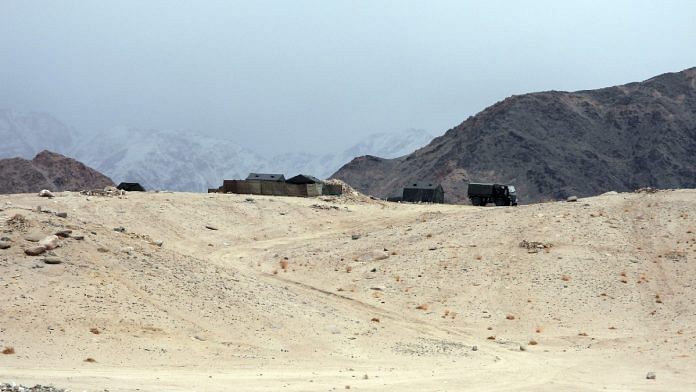New Delhi: India has lost access to 26 of 65 patrolling points that were earlier regularly patrolled by the Indian Security Forces (ISFs) in Eastern Ladakh, according to a report filed by the Superintendent of Police in Ladakh.
The report also goes on to mention how China is continuing its tactic of ‘salami slicing’ in Eastern Ladakh to encroach Indian territory amid the standoff at the Line of Actual Control (LAC).
“Presently there are 65 PPs (Patrolling Points) starting from Karakoram pass to Chumur which are to be patrolled regularly by the ISFs. Out of 65 PPs, our presence is lost in 26 PPs (i.e. PP no. 5-17, 24-32, 37), due to restrictive or no patrolling by the ISFs,” the research paper said.
“Later on, China forces us to accept the fact that as such areas have not seen the presence of ISFs or civilians since long, the Chinese were present in these areas. This leads to a shift in the border under control of ISFs towards the Indian side and a ‘buffer zone’ is created in all such pockets which ultimately leads to loss of control over these areas by India. This tactic of the PLA (China’s People’s Liberation Army) to grab land inch-by-inch is known as ‘Salami slicing’,” it said.
Coming just a month after the 9 December clash in Tawang, the report by Leh SP P.D. Nitya was submitted at the last week’s annual conference of Director Generals (DGs) and Inspector Generals (IGs). Prime Minister Narendra Modi, Union Home Minister Amit Shah and National Security Advisor Ajit Doval had attended the meeting in New Delhi.
ThePrint has a copy of the report.
The PLA has “taken advantage of the buffer areas in the de-escalation talks by placing their best cameras on the highest peaks and monitoring the movement of our forces…,” the report said.
It added that PLA objects the movement of Indian forces even in the buffer zone, claiming it to be ‘their’ area of operation and then further asking them to move back to create more ‘buffer’ areas. This situation, it said, happened with Y nallah at Galwan where the Indian forces were forced to move back to Camp 01 without dominating the higher posts overseeing Y nallah.
Also Read: Did PLA force Galwan captives to make ‘confessions’? Footage surfaces in India-China video war
‘Play safe strategy’
The paper also said that the Army has placed restrictions on the movement of civilians and grazers near the forward areas on the Indian side, indicating their ‘play safe’ strategy that they do not want to annoy the PLA by giving it the chance to raise objections on the areas being claimed as disputed.
“Till September 2021, senior officers of district administration and security forces would easily patrol till Karakoram Pass (35 km from Daulat Beg Oldie) in the DBO sector. However, restrictions in the form of check posts were placed by Army since December 2021 at DBO itself to stop any such movement towards Karakoram Pass as PLA had installed cameras and they would immediately raise objections on the movement from Indian side if not informed beforehand,” it said.
This form of restrictive approach, the report said, has affected the assertiveness of the Indian side, and areas — which were much accessible from India’s side — became an “informal buffer zone”.
It further added that the unfenced borders have been serving as pastures for the nomadic community of Changthang region (Rebos) and given the scarcity of rich pastures, they would traditionally venture into the areas close to the Patrling points.
But since 2014, enhanced restrictions on the grazing movement and areas have been imposed on the Rebos by ISFs and this has caused some resentment against them, the report said.
“The soldiers are especially deployed in disguise to stop the movement of Rebos to the higher reaches that could be objected by the PLA and similarly the development works in the border villages like Demchok, Koyul which are under direct electronic surveillance of the PLA suffers, as they raise objections promptly,” the report said.
Over the years, the report said, this has resulted in the loss of livelihood and change in lifestyle patterns of border villages, which has led to migration and has also led to infighting within communities.
‘If retreating 400m can buy peace, it’s worth it’
The senior police officer also said in the report that the harsh climate, difficult terrain and remoteness of the region affect the morale and motivation of the jawans and officers on ground.
“The terrain and remoteness of the area only reminds the jawans to start a reverse countdown of their deployment time, and each unit wants to complete their tenure and return back to the plains. In a longer duration, they do not see the utility to defend barren acres of land when no population and no economic activity is being carried out, therefore the onus is on us to keep up their motivation and morale high,” the report said.
It further added that during an interaction with a senior officer whose unit is based on forward area, he shared with the SP that if by retreating 400 meters back can buy peace with PLA for 4 years then “it’s worth it”, the report said.
(Edited by Tony Rai)
Also Read: India’s strategic paralysis with China must end. It is time to call out Xi’s border bluff



